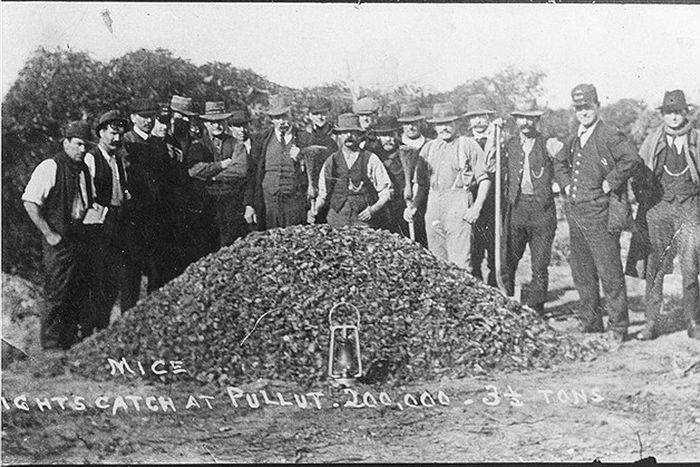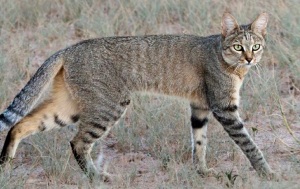It’s hard being a cat person in a dog-person world. 70% of Americans describe themselves as “dog people,” versus only 20% who claim to be “cat people.” Even among people who only own cats, a full 26% of them are “dog people.” (By contrast, only 3% of people who only have pet dogs are “cat people.”) [source]
The dog gets to be man’s best friend, while the poor beleaguered cat is associated with crazy cat ladies.
(I decided to give you a picture of cats instead of cat ladies.)
Dogs were the first domesticated animals, accompanying hunter gatherers on their exploits some 40,000 years ago. We’re not sure exactly how the first dogs began, but pretty soon people began actively selecting for certain traits in their dogs to make them more useful to humans.
Cats appeared much later–less than 10,000 years ago–and appear to have become tame via a very different route.
There is a special class of animals that have become semi-domesticated without humans actually wanting them, which includes mice, rats, and pigeons. These are not tame animals, but neither do they live in the wild , having become adapted to life in and among humans.
Long after humans domesticated dogs, they domesticated grain, and with grain came cities, granaries, and trash; and with those, rats, mice, and pigeons. The animals that could stand to be in close proximity with humans (but out of reach) thrived in the new niche–don’t underestimate just how many mice a bountiful harvest can feed:

First to the mouse plague which has invaded three states and damaged hundreds of thousands of hectares of crops. The rodents may be a familiar pest for farmers but the volume of vermin visible across parts of WA, Victoria and SA hasn’t been seen in more than 15 years. …
CHERYL WILLIAMS, BAYVIEW STREAKY BAY SA: I reckon the other morning I would have got two bucketfuls and there would have been near enough to 2,000 in it because it was piled high. … I had them in the house earlier on and they were climbing the walls and on the furniture. Just everywhere. On the beds, gives me the willies. I’ve had enough of it. I can hardly stand it. …
ALLAN WILLIAMS, BAYVIEW STREAKY BAY SA: … We’ve been taking out 20 to 40 litres every day for the last 100 days which that’s 2,000-odd litres of mice which is – I’ve never seen that amount of mice in me life. …
LEON WILLIAMS: You come out here at night time and it’s just literally a moving mass of mice. By the millions.
Mice and rats are interesting in and of themselves, but I will have to discuss them later. For now, let’s just say they were soon followed by an opportunistic predator:
Early cats probably moved into human settlements to hunt for rodents, and after a while, humans decided this was a useful behavior. Even today, many “pet” cats are expected to earn their keep, catching the mice in and around their homes–unlike the average dog.
(Reports of Medieval Europeans massacring cats are probably overstated–the famous “Cat Massacre” was actually an anti-aristocrat French mob murdering noble pets.)
While dogs have diverged significantly from wolves, the average house cat still looks quite similar to its wild relatives:

Distinct breeds of cats–including most if not all of the more unusual looking ones–are extremely recent, perhaps less than 200 years old, but domestic cats do differ from wild ones in several important ways. They are smaller, lighter, and they meow.
Interestingly, adult wolves do not bark and adult wildcats do not meow. Kittens meow at their mothers, and cats meow at their people, not each other. These are neotenous traits–baby behavior. Dogs will always be wolf pups, never adults, and a cat is always part kitten.
I shall leave you with a bit of light verse, from 9th century Ireland:
The scholar and his cat, Pangur Bán
I and Pangur Ban my cat,
‘Tis a like task we are at:
Hunting mice is his delight,
Hunting words I sit all night.
Better far than praise of men
‘Tis to sit with book and pen;
Pangur bears me no ill-will,
He too plies his simple skill.
‘Tis a merry task to see
At our tasks how glad are we,
When at home we sit and find
Entertainment to our mind.
Oftentimes a mouse will stray
In the hero Pangur’s way;
Oftentimes my keen thought set
Takes a meaning in its net.
‘Gainst the wall he sets his eye
Full and fierce and sharp and sly;
‘Gainst the wall of knowledge I
All my little wisdom try.
When a mouse darts from its den,
O how glad is Pangur then!
O what gladness do I prove
When I solve the doubts I love!
So in peace our task we ply,
Pangur Ban, my cat, and I;
In our arts we find our bliss,
I have mine and he has his.
Practice every day has made
Pangur perfect in his trade;
I get wisdom day and night
Turning darkness into light.


Toxoplasma gondii…
LikeLike
is kind of freaky.
LikeLike
I’ve always liked that poem. Nice to see it again. :)
LikeLiked by 1 person
[…] Source: Evolutionist X […]
LikeLike
I keep a cat in the upstairs part of my house to keep it free of bats and mice.
I keep two dogs in the lower part of my house to keep it free of burglars.
Such is city living….
LikeLike
Nota bene: a Google search for ‘cat lady’ turns up quite different pictures from those for ‘cat woman’ or ‘cat girl’.
In the paragraph:
“There is a special class of animals that have become semi-domesticated without humans actually wanting them, which includes mice, rats, and pigeons. These are not tame animals, but neither do they live in the wild , having become adapted to life in and among humans.”
you may want to change ‘in and among’ to ‘around’ or ‘near’ or some such; in this context ‘in and among’ brings to mind images of rats as bodily parasites, or old peasant tales of the Devil causing a witch to bear rats instead of children. At least, it did for me.
Also, I would point out that cats do in fact meow at each other betimes, though it is rare and methinks different – it sounds like a different vocalization than those intended for humans, usually done in annoyance or in response to another meow.
LikeLike
“in and among”
Haha, good point. I think I originally meant “in and among human settlements.” :)
LikeLike
That pic of the dead mice is from Australia and shows the mice plagues that happen occasionally.
LikeLiked by 1 person
So which catbreed is most evolved.
LikeLike
What do you mean by evolved? Greatest physical difference between breed and wild ancestor?
LikeLike
[…] Petz Week over at Casa Evolutionist X this week… First she wonders Why are people so keen on pets? In Part 2, she tackles the dog question. And the un-numbered Part 3 takes on the Cats: Incomplete Domesticates. […]
LikeLike
Aren’t many other domesticates incomplete by this definition? Equids have formed feral colonies in every continent they have been introduced without any problem. Goats have also fared well, especially on islands without competition. Sheep without their hindering wool I think they would do as well. I don’t know if cattle have adapted to the wild successfully though. And of course most smaller cage bound animals have been more selected for looks rather than anything else, and many still can revert to the wild.
ps. How proven is that people selected for various characteristics in dogs from 40.000 years ago? The most circulating hypothesis is that they are self-domesticates as well.
LikeLike